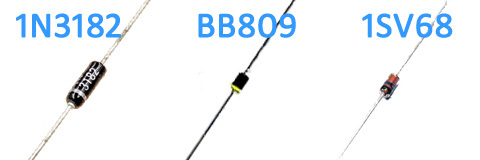Tuesday 14 September, 2021, 08:45 - Amateur Radio, Broadcasting, Licensed, Pirate/Clandestine, Electronics
Posted by Administrator
Before heading down the final straight of the Wireless Waffle lockdown transmitter project, and mounting the horse of the associated receiver, a few words on varicap diodes, or varactors as they're also known. Posted by Administrator
A varicap is a diode which, when reverse biassed (i.e. not conducting) acts as a capacitor. Varying the voltage of the reverse bias, affects the amount of capacitance that the device exhibits. The higher the reverse voltage, the smaller the capacitance. These, are therefore the devices which enable an oscillator's frequency to be tuned with a voltage. Replacing the capacitor in a tuned circuit with a varicap allows the resonant frequency (and thus the frequency of oscillation) to be varied, making a voltage controlled oscillator (VCO).
However, not all varicaps are made the same. The amount of capacitance they exhibit can be very different. Some are designed for use in medium-wave circuits and can have several 100pF of capacitance. Some are designed for UHF and have only a few picoFarads (pF) of capacitance. Some operate only over a relatively narrow range of voltages, some require a very wide range of voltages to perform to their best. There are also differences in the extent to which the capacitance changes between a low reverse voltage and a high one. Some varicaps will have 10 or more times less capacitance at a high voltage compared (say 28 Volts) to a low one (say 1 Volt), whereas others may only have a high to low capacitance ratio of nearer 4.
For use in a VHF VCO being discussed in this series, a varicap with a capacitance varying from around 20pF to 10pF would be about right. Paired with an inductor of around 120nH and together with the stray capacitances of the oscillator circuit, this will enable oscillation over the frequency range of interest. To resonate a 120nH coil at 87.5 MHz requires a parallel capacitance of 27.5pF, falling to 18pF at 108 MHz. So a varicap which can tune from 20pF to 10pF in parallel with around 8pF of stray capacitance would be spot on.

There are a wide range of varicap diodes which can perform this job, and an equal number which can't. Trying to find data online for some devices can prove very difficult as many which are cheaply available are of a vintage where few datasheets remain, and some are originally of Japanese manufacture meaning that the datasheets are primarily in Japanese. Below is as many devices as have been found which ought to be able to do the job in hand. Note that all of these devices are in a two lead, glass-body package (such as the good old 1N4148). There are surface mount devices (SMD) available, and some odd square packages but these have not been listed, due to their lack of aesthetic pleasure-giving.
| Device | Specified Use | Maximum Capacitance and Voltage | Minimum Capacitance and Voltage |
|---|---|---|---|
| BB139 | VHF Tuner | 29pF@3V | 6pF@30V |
| BB329 | VHF & CATV Tuner | 35pF@1V | 3pF@28V |
| BB409 | VHF Tuner | 27pF@3V | 6pF@25V |
| BB609 | VHF & CATV Tuners | 33pf@1V | 3pf@28V |
| BB809 | VHF Tuners (up to 160 MHz) | 42pF@1V | 4.5pf@28V |
| BB909 | VHF Tuners (up to 460 MHz) | 24pF@1V | 3pf@28V |
| 1N3182 | VHF Tuning | 33pf@4V | ? |
| 1S2688 | VHF AFV | 20pF@1V | 2.2pf@10V |
| 1SV68 | VHF/FM Tuner | 32pf@3V | 5pF@25V |
| 1SV97 | VHF Tuning | 25pf@?V | ? |
| 1SV113 | VHF Tuning | 21pF@3V | 3pf@25V |
| 1SV124 | VHF Tuning | 35pF@1V | 3pF@28V |
| 1SV126 | FM/VHF Tuning | unknown | |
| 1SV155 | VHF Tuning | unknown | |
| 1SV184 | FM/VHF Tuning | 50pf@2V | 4-6pf@10V |
Incidentally, if anyone knows of any other devices which can do the job, please post them in the comments and they can be added to the table. Also, if anyone has the precise details of any of the diodes whose parameters are 'unknown', any information on them would be greatly received.
In the VCO design presented in part 1 of this series, two varicaps are used in a back-to-back arrangement. It is important that these two are relatively well matched. Some of the older diodes listed above (such as the BB139 or 1N3182) are not well matched, and the datasheet shows that the exact capacitance value provided at a particular voltage can be as much as 30% different between two devices. This either means measuring and selecting two similar diodes or choosing more modern components whose tolerances are much better. Of course more modern devices are often more expensive, so like many things, there's a trade-off to be had.
add comment
( 308 views )
| permalink
| 



 ( 2.8 / 1058 )
( 2.8 / 1058 )




 ( 2.8 / 1058 )
( 2.8 / 1058 )

